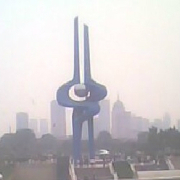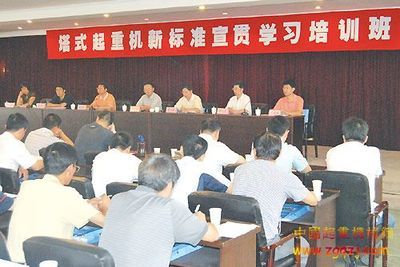Tower crane(塔式起重机)
一篇很简单的介绍塔机的科普文章,我很喜欢。
1.Introduction to How Tower Cranes Work(来看看塔机是怎么工作的)
Tower cranes are a common fixture at any majorconstruction site. They're pretty hard to miss -- they often risehundreds of feet into the air, and can reach out just as far. Theconstruction crew uses the tower crane to lift steel, concrete,large tools like acetylene torches and generators, and a widevariety of other building materials.
When you look at one of thesecranes, what it can do seems nearly impossible: Why doesn't it tipover? How can such a long boom lift so much weight? How is it ableto grow taller as the building grows taller? If you have everwondered about how tower cranes work, then this article is for you.In this article, you'll find out the answers to all of thesequestions and more!
2.Parts of a Tower Crane (塔机的组成)
All tower cranes consist of the same basicparts:
The base is bolted to a large concrete pad thatsupports the crane.
The base connects to the mast (or tower), whichgives the tower crane its height.
Attached to the top of the mast is the slewingunit -- the gear and motor -- that allows the crane torotate:
On top of the slewing unit are three parts:
The long horizontal jib (or working arm), whichis the portion of the crane that carries the load. A trolley runsalong the jib to move the load in and out from the crane'scenter:
The shorter horizontal machinery arm, whichcontains the crane's motors and electronics as well as the largeconcrete counter weights:
The operator's cab
The machinery arm contains the motor that liftsthe load, along with the control electronics that drive it and thecable drum, as shown here:
The motors that drive the slewing unit arelocated above the unit's large gear
Now let's find out how much weight thisequipment can handle.
3.How Much Weight Can They Lift? (塔机是怎么吊重的?)
A typical tower crane has the following specifications:
Maximum unsupported height - 265 feet (80 meters)
The crane can have a total height much greaterthan 265 feet if it is tied into the building as the building risesaround the crane.
Maximum reach - 230 feet (70 meters)
Maximum lifting power - 19.8 tons (18 metric tons), 300tonne-meters (metric ton = tonne)
Counterweights - 20 tons (16.3 metric tons)
The maximum load that the crane can lift is 18metric tons (39,690 pounds), but the crane cannot lift that muchweight if the load is positioned at the end of the jib. The closerthe load is positioned to the mast, the more weight the crane canlift safely. The 300 tonne-meter rating tells you the relationship.For example, if the operator positions the load 30 meters (100feet) from the mast, the crane can lift a maximum of 10.1tonnes.
The crane uses two limit switches to make surethat the operator does not overload the crane:
The maximum load switch monitors the pull on thecable and makes sure that the load does not exceed 18 tonnes.
The load moment switch makes sure that theoperator does not exceed the tonne-meter rating of the crane as theload moves out on the jib. A cat head assembly in the slewing unitcan measure the amount of collapse in the jib and sense when anoverload condition occurs.
Now, it would be a pretty big problem if one of these things fellover on a job site. Let's find out what keeps these massivestructures standing upright.
4.Why Don't They Fall Over? (塔机为什么不倒呢?)
When you look at a tall tower crane, the wholething seems outrageous -- why don't these structures fall over,especially since they have no support wires of any kind?
The first element of the tower crane's stabilityis a large concrete pad that the construction company pours severalweeks before the crane arrives. This pad typically measures 30 feetby 30 feet by 4 feet (10 x 10 x 1.3 meters) and weighs 400,000pounds (182,000 kg) -- these are the pad measurements for the craneshown here. Large anchor bolts embedded deep into this pad supportthe base of the crane:
So these cranes are essentially bolted to theground to ensure their stability. In the next section, you'll learnhow tower cranes "grow."
5.How Do They Grow? (塔机是怎么升高的)
Tower cranes arrive at the construction site on10 to 12 tractor-trailer rigs. The crew uses a mobile crane toassemble the jib and the machinery section, and places thesehorizontal members on a 40-foot (12-m) mast that consists of twomast sections. The mobile crane then adds the counterweights.
The mast rises from this firm foundation. Themast is a large, triangulated lattice structure, typically 10 feet(3.2 meters) square. The triangulated structure gives the mast thestrength to remain upright.
6. To rise to its maximum height, the crane grows itself one mastsection at a time! The crew uses a top climber or climbing framethat fits between the slewing unit and the top of the mast. Here'sthe process:
The crew hangs a weight on the jib to balancethe counterweight.
The crew detaches the slewing unit from the topof the mast. Large hydraulic rams in the top climber push theslewing unit up 20 feet (6 m).
The crane operator uses the crane to liftanother 20-foot mast section into the gap opened by the climbingframe. Once bolted in place, the crane is 20 feet taller!
Once the building is finished and it is time forthe crane to come down, the process is reversed -- the cranedisassembles its own mast and then smaller cranes disassemble therest.
主要的文字部分是从网上当来的,已没有出处了,如果涉及版权,请多多包涵了。
起重吊装系列讲座(一) (2009-05-0921:56:00)
起重吊装系列讲座(二)(2009-05-1918:42:02)
起重吊装系列讲座(三)(2009-05-2308:22:11)
起重吊装系列讲座(四)(2009-05-2412:09:03)
起重吊装系列讲座(五)(2009-05-2518:16:06)
起重吊装系列讲座(六)(2009-06-0222-41-20)
塔机(塔式起重机)讲座(三)(2009-03-2623:04:31)
塔机(塔式起重机)讲座(二)(2009-03-11 01:20:00)
塔机(塔式起重机)讲座(一)(2009-03-11 01:10:00)
 爱华网
爱华网


